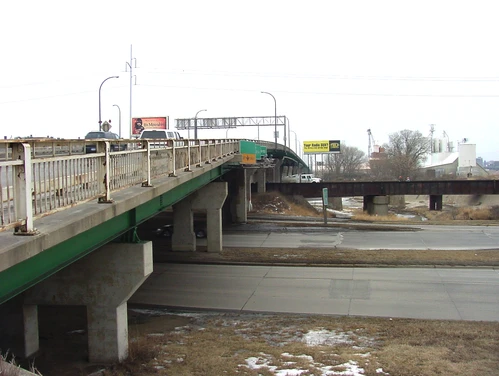- Year constructed: 1936
- Alternate name: Grand Avenue Viaduct, Gordon Avenue Viaduct
- Bridge type: Steel Plate Deck Girder
- National Register of Historic Places status: Eligible
- Length: 3970 feet
- Width: 56 feet
- Spans: 57
- FHWA: 052830
- Jurisdiction: Iowa DOT
- Location: U.S. 75 over Chicago & Northwestern Railroad and Stockyard in Sioux City, Section 34, T89N-R47W (Sioux City Township)
Details
Viaducts have long been a part of the urban fabric of Iowa. Beginning as early as the 1880s, the railroads and municipal authorities were concerned about the dangers and bottlenecks created by on-grade, inner-city crossings. Of all the viaducts built by ISHC during this period, none could approach the Grand Avenue Viaduct in Sioux City for scale. Carrying this city street over railroad tracks, other city streets and the Floyd River, this multiple-span steel deck girder structure extends over three-quarters of a mile through the downtown district.
The impetus for the viaduct came in 1934, when Congress, in an effort to create jobs during the Depression, passed the Hayden-Cartwright Act allowing federal monies to be used for road and bridge construction within municipalities. Taking advantage of the legislation, the Iowa State Highway Commission began the design work for the Sioux City viaduct in 1935. But rather than design the immense structure in-house, however, ISHC commissioned Kansas City engineers Ash, Howard, Needles and Tammen for the project. AHNT completed the drawings, and the highway commission designated the project WPGM 604, soliciting bids in June 1936 for the viaduct's construction. The following month a contract was awarded to the C.F. Lytle Company of Sioux City for $783,932.01. Construction commenced in July and was completed in November. Extending from Court Street to South College Street, the Grand Avenue Viaduct was comprised of some 54 plate deck girder spans, with a maximum span length of 127 feet and a roadway width of 32 feet, with two 4-foot sidewalks. The structure was huge, consuming almost 13,000 cubic yards of concrete, 1.1 million pounds of reinforcing steel and 6.2 million pounds of structural steel. The bridge, as completed in November 1936, featured ornamental guardrails and 49 light standards.
The viaduct carried inner city traffic as well as the traffic of U.S. Highway 75 for 26 years, with only maintenance-related repairs. In 1962, however, three new spans were added to extend the viaduct over the relocated channel of the Floyd River. Then, in 1965 the structure's roadway was increased to its current 56-foot width by adding welded steel girders and extending the existing piers. Removed during this latter alteration were the original lights and rails. Grand Avenue has since been renamed Gordon Avenue, and the viaduct continues to carry heavy traffic through downtown Sioux City. The Grand Avenue Viaduct is distinguished as Iowa's longest grade separation and, indeed, the state's longest bridge other than the Mississippi River structures. Although altered, it is a massive and significant example of highway bridge construction in Iowa in the 1930s.
Adapted from Fraser 1993
Areas Served
- Woodbury
